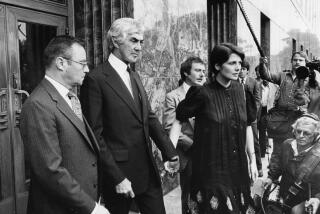When Rumors Are Clothed as Truth
Heard the one about clothing designer Tommy Hilfiger?
Seems he went on “The Oprah Winfrey Show” and made racist remarks about African Americans. A furious Winfrey threw him off the show.
An incredible story--if it had actually happened.
Hilfiger is the latest celebrity designer to become embroiled in an urban legend alleging that he wants to see his clothes only on the backs of white people. Although the rumors apparently have been circulating on the Internet since November, the company only recently responded.
“Tommy Hilfiger did not make the alleged inappropriate racial comments,” said a company statement posted on the Internet. “. . . Hilfiger wants his clothing to be enjoyed by people of all backgrounds and his collections are put together with the broadest cross-section of individuals in mind. To reinforce this, he features models of all ethnic backgrounds in his fashion shows and advertisements.”
In one cybermyth, Hilfiger supposedly told style reporter Elsa Klensch of CNN that he didn’t think Asians looked good in his clothes. Then, as the story morphed, he told Winfrey the same thing about African Americans, at which point she threw him off the set.
Yet representatives of both shows deny Hilfiger ever appeared as a guest.
Similar stories have plagued designer Liz Claiborne for some eight years. She, too, supposedly stated her whites-only preference to Winfrey. And that rumor, circulated by word-of-mouth, had such legs that film director Spike Lee denounced the designer in a 1992 Esquire interview.
“Claiborne got on,” he said, “and said she didn’t make clothes for black people. . . . It definitely happened. Get the tape.”
But it didn’t. And an “Oprah” producer said she has no idea how or why rumors about the fashion designers got started.
Hilfiger’s all-American preppy wear has been embraced by several musicians, including rappers Grand Puba and Chef Raekwon, who even evoke the designer’s name in their lyrics. And the New York-based Hilfiger had this to say about his high-profile supporters in an interview in August with The Times: “I’m complimented. I know they can wear anything. . . . They choose my clothes. It’s a true, true honor. I think these kids are so cool.”
But such public comments, and the fact that the chairman of Hilfiger’s $400-million empire is Asian American, apparently have no impact on the grapevine.
Patricia Turner, associate professor of African-American studies at UC Davis and the author of “I Heard It Through the Grapevine: Rumor in African-American Culture” (University of California Press, 1993), has been following the Hilfiger hearsay for several weeks.
She says it echoes an incident in the late 1980s involving Troop clothing. The rumor mill branded that line, a favorite label among young African Americans, saying its backers were racists with ties to the Ku Klux Klan.
One theory behind such rumors is that they’re a form of consumer backlash, Turner says.
“One of the common denominators with these [targeted] clothing manufacturers is that they’re usually very popular clothing, a little pricey, and usually garments that took off and were successful right away,” Turner says. “. . . Some people can walk into a store and say, ‘No way am I spending this amount of money.’ Others, the temptation is so great, if someone says, ‘You know what he said on “Oprah,” ’ it’s easier to leave the clothes in the store.”
Beneath the fabrications is a message: “There are very elaborate, sophisticated campaigns to get us to spend money on clothing, and maybe that’s not always a good thing, especially for young people. Maybe they should be spending money on textbooks instead of a sweatshirt.”
And, as Hilfiger discovered, the Internet lends stories a certain legitimacy.
“The credence,” Turner says, “comes in people saying, ‘I saw it on “Oprah,” I saw it on “60 Minutes.” ’ There’s something authenticating it, something you have faith in. The Internet is new and seductive, and there’s a portion of the population that thinks that if it’s on a computer, it must be true.”






